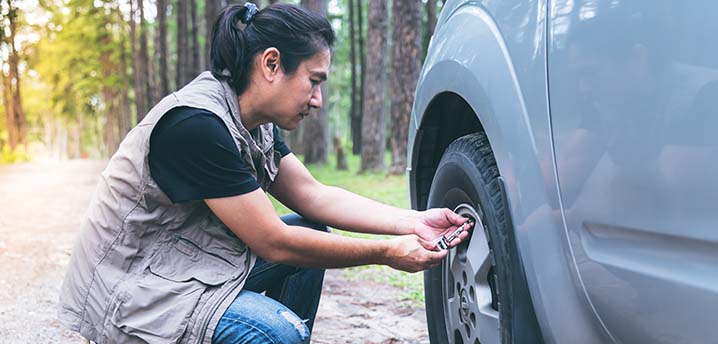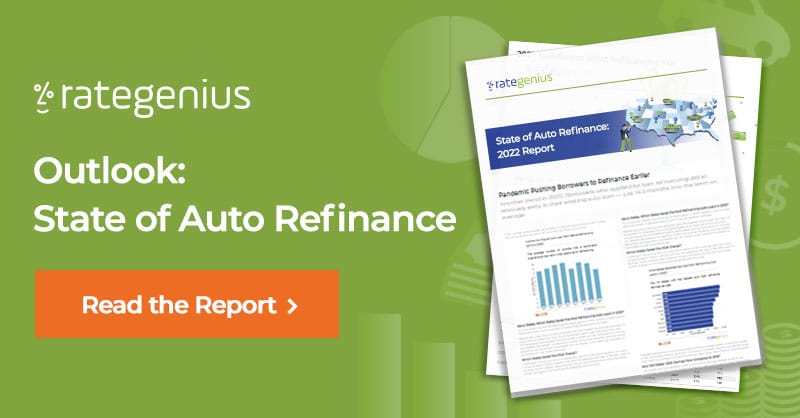Maintaining the right pressure in your car’s tires is imperative for both safety and performance.
Whether you’re a total car novice or mechanic by trade, you probably know tires are one of the most important aspects of our vehicles. Our tires quite literally keep us on the road, so maintaining them is key to both safety and convenience.
Wear and tread are common concerns when it comes to tire maintenance. However, it’s just as important to maintain proper tire pressure, especially in the months (and years) between replacements. Doing so can not only improve the longevity of your tires but also impact your vehicle’s stability, efficiency, and ride.
Here’s a look at just how important your car’s tire pressure really is, how to determine the optimal tire pressure for your vehicle, and what you can do to make your tires last as long as possible.
The Importance of Correct Tire Pressure
Few of us think about our car’s tire pressure on a daily basis, at least not unless a tire pressure warning light pops on or we see, feel, or hear something askew. However, ensuring that our tires are filled to the correct pressure can be one of the most important checks we make.
Driving With Low Tire Pressure
Depending on where you live, you and your neighbors might all experience “low tire pressure day” at the same time, typically when temperatures drop in the fall and early winter. When this happens, the air in your tires will become more dense and the tire pressure will drop — sometimes by a substantial amount and often, overnight.
In general, tire pressure will decrease by about 1 pound per square inch for every 10 degree drop in temperature. This means that come seasonal weather changes, you should expect to need a bit more air in your tires to compensate.
However, the weather isn’t the only reason you might have low pressure in one or more of your tires. Low tire pressure could also be caused by:
- A hole or other damage to your tire
- Worn and/or cracked tires
- Damaged or leaking valve stem
- A bent rim or leaking wheel
- A change in altitude, if you’re traveling
Some tires can also lose air pressure through the tire casing, just as a natural function of the rubber. This permeation can result in a loss of about 1 to 3 PSI per month.
The Effects of Low Tire Pressure
Driving around with low pressure in one or more tires can be a costly, and even dangerous, mistake. Here are some of the things that can happen when you drive on underinflated tires over a period of time.
- Excessive tire wear. A tire that is underinflated will not ride on the road properly. This typically results in more wear on either side of the tire, versus the center of the tread, and can cost you by reducing the life of the tire and needing to be replaced sooner.
- Tire failure. As you drive, the air inside your tires will naturally heat up as a function of road friction. If your tires are underinflated, though, your tire sidewalls will flex more than they are intended, building up heat within that under-pressure air. This can lead to a potential blowout and even an accident.
- Problems handling. Steering, braking, and general handling can all be affected by low tire inflation. Lower pressure allows for more flexibility in your tires’ sidewalls, leading to a less responsive tire with less traction. Whether cornering through a mountain pass or trying to avoid a sudden accident, this reduced stability could lead to an accident.
- Reduced fuel efficiency. When your tires are underinflated, your vehicle has to work harder to travel the same distance, compared to riding on properly-inflated tires. This can reduce your fuel economy (wasting money on gas) and also result in unnecessary added emissions.
According to the EPA, underinflated tires will reduce your fuel efficiency by about 0.2% for every 1 pound per square inch of underinflation. They estimate that drivers can improve gas mileage by about 3%, just by maintaining proper tire pressure.
More Pressure Isn’t Better
While underinflated tires are obviously a costly — and sometimes, dangerous — situation, overinflation isn’t necessarily any better. In fact, overinflated tires can be just as hazardous and inefficient.
Overinflated tires also fail to ride the road correctly. This results in uneven or premature wear: rather than wearing evenly across the width of the tread, an overfilled tire will primarily wear out in the center. This uneven wear can create a hazard and result in worn tires that need to be replaced sooner than expected.
As with underinflation, overfilled tires also result in a loss of handling. Because there is less contact with the road surface, overinflated tires may lack in sudden handling, emergency maneuvers, and even cornering.
What Is the Right Tire Pressure for My Car?
Ideal tire pressure is very specific to your vehicle and its maintenance recommendations. The proper tire inflation for your card can vary depending on:
- Size and style of the tire
- Manufacturer
- Vehicle type
- Driving conditions
- Weather
When trying to find the right tire pressure for your car, you’ll want to see what your vehicle manufacturer recommends. This information can typically be found on a sticker inside the driver’s side door jamb, though it may also be located in your glove box or on the edge of the door.
This sticker will provide you with tire recommendations from your car manufacturer, including the preferred PSI range. However, if you’ve swapped out your tires and have a different size, profile, or significantly different style than your vehicle’s original manufacturer, you may want to check the recommendations from the tire manufacturer instead.
For this, you’ll need to look at the tire itself. Manufacturers will list the recommended tire pressure for that specific brand, size, tread, and style of tire, directly on the sidewall. In some cases, they will list a maximum pressure instead of a recommended PSI range; be sure that you know which number you’ve found before filling your tire.
How Do I Know if My Tires Need Air?
There are a few easy ways to tell if your tires need more or less air.
Listen to your car
Many modern cars have a built-in tire pressure monitoring system, or TPMS. This system lets you know when you have a low tire pressure warning, and may even tell you which tire has the issue. However, they don’t typically warn you of overfilled tires, and not all systems will tell you where the problem lies.
Some TPMSs might tell you exactly how much pressure you have in each tire. This can be helpful for monitoring your tires throughout seasonal weather changes, as well as detecting sudden issues. It can still be beneficial to check your tires’ pressure manually every once in a while, though, as TPMSs aren’t without flaws.
Look at your tires
Few of us could spot a tire that is over- or under-inflated by just a couple PSI. However, the appearance of your tires can make it easy to spot a serious underinflation or other issue.
Visually inspecting your tires regularly can help you identify low pressure, high pressure, or uneven wear on your tires’ tread. Make it a point to walk around your car and look at each tire on a regular basis, such as when you fill up at the gas station. This will also help you identify damage, such as embedded nails, or the start of an issue such as a sidewall bubble.
Check the pressure… the old fashioned way
In addition to a visual inspection — and even if your vehicle has a TPMS built in — you may still want to check your tire pressure manually on a regular basis. This is most easily done with a tire pressure gauge.
Some folks check their tire pressure every time they get gas, while others might check once a year (if they remember). To be safe, try to check every month or so. This will help you identify potential problems before they get worse, and also teach you how to better identify your tire pressure just by visual inspection.


Using a Tire Pressure Gauge
A pressure gauge is an affordable, small tool that can be invaluable when it comes to tire maintenance. And you can simply keep one in your glove box for tire pressure checks on the go.
Tire pressure gauges measure the pounds per square inch (PSI) within your tire. To get the most accurate reading, ensure that your tires are cold — this means either checking tire pressure readings first thing in the morning or after your vehicle has been sitting for at least a few hours.
To get your tire’s air pressure reading, you should:
- Remove the cap from your tire’s valve stem
- Firmly press the gauge into the stem
- Read the number given on the gauge
Depending on the style— either a pen gauge, dial gauge, or digital gauge — your readout will be a bit different.
Additional Tire Maintenance Tips
In addition to checking your tire pressure on a regular basis, there are a few other things you can do to save money and extend the life of your vehicle’s tires.
Check tread depth frequently. It’s important to keep an eye on your tires’ tread depth over time. As you drive, normal wear will reduce this depth. It gets too low, your vehicle’s handling will be affected.
Rotate your tires frequently. To ensure even wear across all four tires, it’s important to rotate them on a regular basis. Depending on your manufacturer’s recommendation, you may want to rotate them after a certain number of miles or just every time you change your oil.
Inspect for damage. You should check for nails, gouges, bubbles, or any other signs of damage regularly; this can help you spot issues before they get worse or cause a blowout. You might want to walk around and check your tires visually every time you get gas, for instance.
About The Author
RateGenius
A better way to refinance your auto loan. RateGenius works with 150+ lenders nationwide to help you save money on your car payments. Since 1999, we've helped customers find the most competitive interest rate to refinance their loans on cars, trucks, and SUVs. www.rategenius.com
;)




